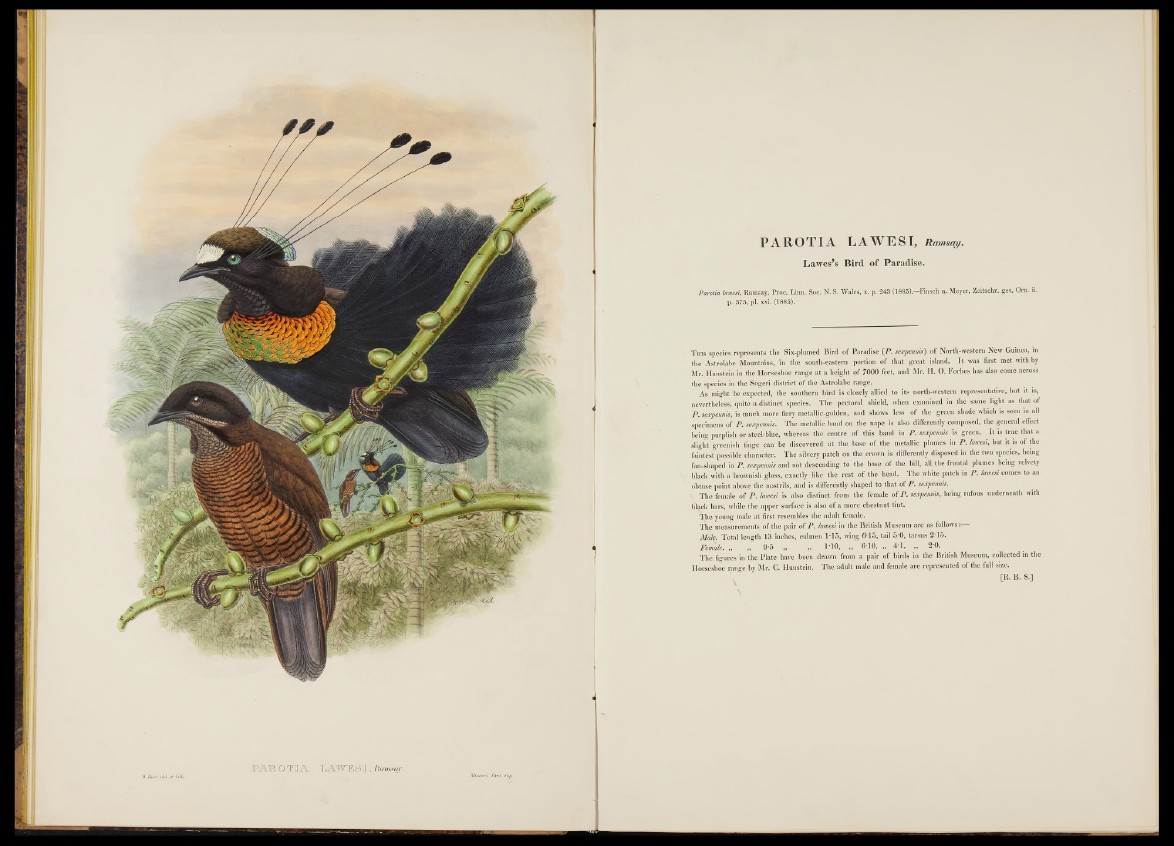
JPAK0 T IA W W aBm SM R i
PAROTIA LAWESI , Ramsay.
Lawes’s Bird of Paradise.
Parotia lawesi, Kamsay, Proc. Linn. Soc. N . S. Wales, x. p. 243 (1885).—Ensch u. Meyer, Zeitschr. ges. Orn. ii.
p. 375, pi. xvi. (1885).
T h is species represents the Six-plumed Bird o f Paradise (P . sexpennis) o f North-western New Guinea, in
the Astrolabe Mountains, in the south-eastern portion o f that great island. It was first met with by
Mr. Hunstein in the Horseshoe range at a height o f 7000 feet, and Mr. H. O. Forbes has also come across
the species in the Sogeri district o f the Astrolabe range.
As might be expected, the southern bird is closely allied to its north-western representative, but it is,
nevertheless, quite a distinct species. The pectoral shield, when examined in the same light as that of
P . sexpennis, is much more fiery metallic-golden, and shows less o f the green shade which is seen in all
specimens of P . sexpennis. The metallic band on the nape is also differently composed, the general effect
being purplish or steel-blue, whereas the centre of this band in P.-sexpennis is green. It is true that a
slight greenish tinge can be discovered at the base o f the metallic plumes in P . lawesi, but it is o f the
faintest possible character. The silvery patch on the crown is differently disposed in the two species, being
fan-shaped in P . sexpennis and not descending to the base of the bill, all the frontal plumes being velvety
black with a brownish gloss, exactly like the rest o f the head. The white patch in P . lawesi comes to an
obtuse point above the nostrils, and is differently shaped to that of P . sexpennis.
■■ The female o f P . lawesi is also distinct from the female o f P . sexpennis, being rufous underneath with
black bars, while the upper surface is also o f a more chestnut tint.
^fhe young male at first resembles the adult female.
Thp measurements o f the pair o f P . lawesi in the British Museum are as follows:
Male. Total length 13 inches, culmen 1*15, wing 6*15, tail 5 -0, tarsus 2 ‘15.
Female. „ „ 9*5 „ „ 1*10, „ 6*10, „ 4*1, ,, 2 -0.
The figures in the Plate have been drawn from a pair of birds in the British Museum, collected in the
Horseshoe range by Mr. C. Hunstein. The adult male and female are represented o f the full size.
[R. B. S.]